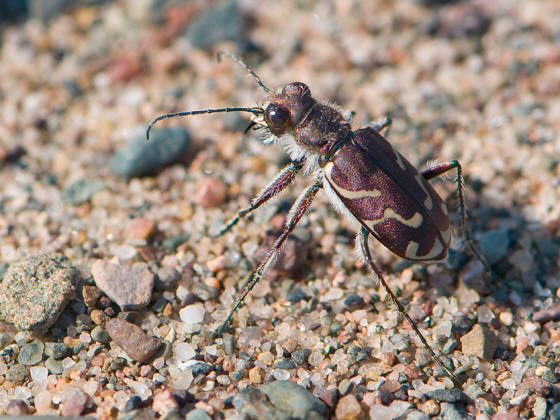Reproduction
As there isn't adequate research in the reproduction of this species, it is assumed that all tiger beetles, genus Cicindela, reproduce and live the same life cycle. Tiger beetles are diecious, meaning that their genders are separated instead of having both sex organs in the same organism (Pearson 2001). Adults have special structures for fitting together during copulation. The male has setae thickly covering their front legs for holding onto the female, and the female has a groove on her back for the male's mandibles (Pearson 2001). During copulation, the males "deposit spermatophores in the bursa of the...females for storage until the eggs are matured and ovulated" (Pearson 2001). To prevent from re-mating immediately, the male guards the female by grabbing her thorax with his mandibles and riding on her back to discourage other suitors (Tiger Beetles of Nebraska 2006).
Life Cycle
When the time is right, the female lays the eggs in the soil in a burrow she has made and then covers the burrow with soil to keep the eggs safe from predators (Tiger Beetles of Nebraska 2006). The eggs hatch into larvae, who then dig their way to the soil surface, using their head as a shovel (Tiger Beetles of Nebraska 2006). They don't leave the burrow right away, however. The larvae use the burrow as a shelter, as well as for a hiding place. The larvae hides in the burrow and waits for prey, as such small arthropods, to come by (Tiger Beetles of Nebraska 2006). When prey comes near, the larva ambushes it, grabbing it with enormous jaws and pulling it down into the burrow (Tiger Beetles of Nebraska 2006). There, the larva secretes digestive enzymes to break the food down before ingesting it (Tiger Beetles of Nebraska 2006). "Tiger beetle larvae are unique in that they have hooks located on the back of their abdomen to anchor them to the side of the burrow while they subdue large prey" (Tiger Beetles of Nebraska 2006). This stage of the life cycle lasts up to four years in some species.
The next stage is the pupal cell. The larvae go a few inches deep into their burrow and plug the entrance (Tiger Beetles of Nebraska 2006). It spends two to three weeks here without feeding. The pupa is the transitional stage from larva to adult (Tiger Beetles of Nebraska 2006).
When the adult emerges from the pupa, it waits three days for its exoskeleton to harden (Tiger Beetles of Nebraska 2006). Even after this waiting period, the beetle is still soft and lightly colored, making it vulnerable (Tiger Beetles of Nebraska 2006). Not long after emerging as adults, the beetles are reproductively mature (Tiger Beetles of Nebraska 2006), and the cycle starts over again.
